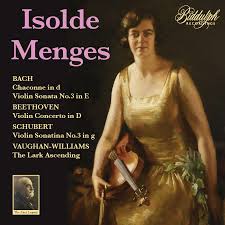
This is something special: a Biddulph twofer celebrating the recordings of Isolde Menges (1893-1976), This is a violinist who was a student of the great Leopold Auer (she also studied with Carl Flesch). She founded a string quartet that gave a complete Beethoven cycle at Wigmore Hall in 1938. Born in Hove to a German fatehr and English mother, she gave her first recital (from memory) aged 3.5. It was when she was sent to St Petersburg that she studied with Auer (he called her “one of the most gifted” of his students). Menges made her debut at Queen’s Hall in 1913, playing the Tchaikovky Concerto and Lalo’s Symphonie espagnole; the stage was set for an international career.She became an annual visitor to the Proms; in 1931 she joined the staff of the Royal College of Music, where she taught fo 40 years, retiring only in 1961.
Isolde Menges played a Guarneri ‘fillies Andrae’ (the father of Bartolomo Giuseppe Guarneri ‘del Gesù’). She died in 1916 in Richmond, Surrey.
The performance Bach E-Major Violin Sonata (BWV 1016) is characterised by a purity before it’s time. Portamenti are almost completely absent; and cleanly there is an intent of respecting Bach’s musical surfaces:
(In a more modern performance previously we met Chiara Zanini and Giolia Nuti on Arcana, coming off a performance during a previous Itinéraire Baroque)
Menges’ G-string in the Bach Air almost sounds like a viola, so deep and expressive is it. Eileen Beattie is the pianist here, perhaps not quite as sensitive as Balsam but when Menges presents the prefer pianissimo at the theme’s second statement, the world stops:
It is counterbalanced by the Gavotte for the E-Major Violin Partita, but with piano (it’s the Kreisler arrangement) – it complements the Air perfectly, moving from interior to exterior statement, from long legato lines to light staccato. Here, Beattie matches Menges’ light touch (some fabulously in-tune stopping, from Menges, too).
But it is the true solo pieces that really count: a massively impressive Fugue from the G-Minor Violin Sonata and a powerful and yet nuanced Chaconne.
Throughout, Biddulph’s transfers are superb. Eric Wen is well-known in the business (the Reissue Producer here); I had not come across Reissue Engineer Raymond Glaspole before but he clearly knows his stuff. Surface noise is at a minimum, but most of all Menges’ sound acmes though, and with it each and every subtlety of he playing (and there are many). All of the records are HMVs of various descriptions: the B series, plus C, D and E series.
The Beethoven recording initially seems a problem – how could it not be, this is from September 1923, for HMV (D1767/71). The timpani sound, well hardly like timpani, and one wonders how many first violins are used. This is though a nicely brisk Allegro ma non troppo. There are certainly some tempo distortions from Ronald that would most certainly not pass muster today; but it is worth it for the sweetness of Menges’ top. Tis may be the first Beethoven Concerto recording, too. The cadenza is the Joachim, a tour de force:
The jewel in Menges’ crown is her high register, and, hearing Menges, I have not gleaned such enjoyment and awe of Beethoven’s magic in the Larghetto since a performance by Shumsky at the Festival Hall sometimes the 1980s … certainly occasionally the orchestral sound fails (the pizzicatos are hardly registered as such) but how wonderful to hear the bassoon lines so clearly:
The finale is full of life, crowning a terrific performance.
Lovely to see two Handel Violin Sonatas beginning the second disc: Op. 1/1 (HWV 361) and Op. 1/13 (HWV 371). her his some portamento here, but somehow Menges is convincing;
Eileen Beattie is the pianist here again, light as Menges in the faster movements. Listen to this, from the Sonata HWV 371:
Schubert next, the G-Mnor Sonata, D 408 – a much under-rated work, full of drama, with passages in the first movement sounding like an orchestral reduction. The amazing Arthur de Grief is the pianist here:
The slow movement is a dream:
This is a terrific performance, teh finale gentle and songlike.
Her pianist, Arthur De Greef, was himself a noted composer: if you an find it, there is an excellent CD on the Talent label that features his Second Piano Concerto with Arthur Pizarro on piano and Yannick Nézet-Séguin as conductor; as pianist, the excellent APR label (Appian Piano Recordings) has released his solo and concerto recordings – anything from this label is worth having!. And I love De Greef forever for including recording some keyboard music by Grétry …
The balance of the release is short pieces: a gloriously flowing Schubert Ave Maria in the Wilhelmj arrangement (lots of G-string there), a fascinating Hungarian-tinged piece by Jenő Hubay (Hejre Kati, Op. 32) and the same composer’s lovely Der Zephyr. Let’s hear the latter, to enjoy Menges’ singing high register:
Yes, Chopin on violin is always slightly odd (to a pianist’s ears) whereas Wieniawski (À la zingara) always fits. And for all the fun of de Falla, it is Stanford (whose music has been covered multiple times on Classical Explorer) that brings rarity and interest via ‘The Leprichaun’s Dance,’ the third of Four Irish Dances, Op. 89 (Eileen Beatte, piano):
There is always an exception to prove the rule, and Menges’ version of Elgar’s Salut d’amour is full of needless putamen. But thankfully the set does not end there: instead it is with Vaughan Williams’ The Lark Ascending, with an unnamed orchestra under Sir Malcolm Sargent. This was the premiere recording of this work , and it is remarkably fresh. he must moves; the nat-stasis of som modern performances seems a world away. This is a fresh, wonderful performance, which at time absolutely glows.
A superb release, so much more than mere historical interest.
This twofer is available at Amazon at the time of writing at 18% off.









